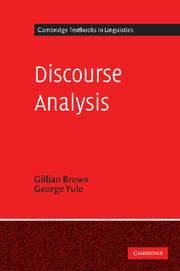Book contents
- Frontmatter
- Contents
- Preface
- Acknowledgements
- Transcription conventions
- 1 Introduction: linguistic forms and functions
- 2 The role of context in interpretation
- 3 Topic and the representation of discourse content
- 4 ‘Staging’ and the representation of discourse structure
- 5 Information structure
- 6 The nature of reference in text and in discourse
- 7 Coherence in the interpretation of discourse
- References
- Subject index
- Author index
Transcription conventions
Published online by Cambridge University Press: 05 June 2012
- Frontmatter
- Contents
- Preface
- Acknowledgements
- Transcription conventions
- 1 Introduction: linguistic forms and functions
- 2 The role of context in interpretation
- 3 Topic and the representation of discourse content
- 4 ‘Staging’ and the representation of discourse structure
- 5 Information structure
- 6 The nature of reference in text and in discourse
- 7 Coherence in the interpretation of discourse
- References
- Subject index
- Author index
Summary
The general issue of what a transcription represents is considered at length in 1.2. In the transcriptions we present in this book, a variable amount of detail is included from one to the next, for the straightforward reason that different extracts are studied for different purposes.
In the transcription of spoken data we always attempt to record as faithfully as possible what was said and we have avoided ‘tidying up’ the language used. Consequently some apparently ungrammatical forms, as well as occasional dialect forms, appear in several extracts. In addition, there are examples of repetition, hesitation, and incomplete sentences commonly found in transcripts of spoken data.
The occurrence of short pauses is marked by −, longer pauses by +, and extended pauses by ++. A detailed discussion of pausing is presented in 5.1. In the intonational representations which accompany some extracts, a simple three-line stave is used. The lines of the stave represent the top, mid and low points of the speaker's pitch range (for a detailed discussion of intonational representation, see Brown, Currie & Kenworthy, 1980).
- Type
- Chapter
- Information
- Discourse Analysis , pp. xiiPublisher: Cambridge University PressPrint publication year: 1983



